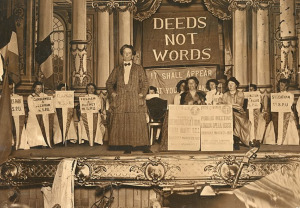Sebastian Kim
The logic that more women in parliament means better legislative considerations for gender equality has led more than 84 countries to adopt gender quotas to improve the selection of female candidates running for office (Tripp & Kang 2007). However, the relationship between the number of women in parliament and gender equality is not simple; in fact, there has been a lack of research on the underlying processes behind such a relationship. This essay will explore such mechanisms through the identification of the link between descriptive and substantive representation, and the exploration of positive impacts of gender quotas within parliaments. Then, this essay will shift its focus to the idea that we need more female party elites, not simply more women, in parliaments. Subsequently, this essay will also identify additional political factors that influence gender equality over and above the mere number of female parliamentarians. Overall, this essay will argue that electing more women to parliaments does lead to better gender equality in society.
Having more women in parliament leads to greater gender equality as there are more legislators who can substantively represent women through their responsiveness to women’s policy interests. Substantive representation of women occurs when representatives take legislative actions in line with interests of women based on ideological congruence (Clark et al. 2019). Female parliamentarians are equipped to represent fellow women better than their male counterparts, as supported by the theory of the politics of presence. Since female politicians share common experiences with other women, such as the exposure to sexual harassment, they bring women’s perspectives to politics based on their distinct interests in certain policy areas, grounded in experiences as women (Tripp & Kang 2007). Such a representational effect is reflected in distinctive legislative behaviours of female parliamentarians. Quantitatively, female politicians view the representation of women’s interests as part of their duty, they are more inclined than their male counterparts to support bills related to women’s issues and they more frequently contact women’s organisations outside parliaments (Celis 2009). Female parliamentarians on average spoke 13.7 times on women’s issues in the House of Commons of the Quebec National Assembly, twice as frequently as male parliamentarians (Tremblay 1998). Further, analysis of the Argentine Congress between 1983 and 2007 found that a woman legislator would ‘never be likely to write fewer than two gender-related bills per year’ (Htun et al. 2013: §12). Qualitatively, female parliamentarians often bring up new policy issues related to women. In Belgium, ‘female representatives were responsible for the growth and diversification of women’s rights in Congress in the period 1953-1992’ (Celis 2009: 106); for example, through the consideration of gender discrimination regarding minimum wages for the first time (Ibid: 105). This demonstrates that an increase in women MPs broadens the scope of women’s legislative representation by including new, unconsidered issues regarding women’s interests. Therefore, more women in parliaments leads to improved gender equality based on better substantive representation of women thus far marginalised in the political realm.
Moreover, gender quotas lead to better gender equality as they play a central role in both women’s representation in parliaments and the placement of competence as the most important criterion for legislators. Gender quotas provide a shortcut to overcome electoral constraints posed only to women due to gender discrimination. Male-dominated legislatures represent a form of electoral preferential treatment for men that is entrenched; therefore, strict measures such as quotas are adopted for women to break through such institutional barriers (Tripp & Kang 2007). These quotas not only allow qualified women who were held back from political office to win but also make people aware of gender imbalances in societal institutions, helping counter the superficial illusion of gender equality (Besley et al. 2017). Furthermore, quotas increase the competence of politicians by replacing mediocre men with qualified women. In opposition to the common criticism that quotas are anathema to meritocratic principles, a 10% increase in female representation through quotas raised the proportion of competent men by 3% (Vieira 2017). This helps to create an environment where equally competent men and women can be similarly rewarded with electoral positions, making the public sphere gender neutral.
It is also important to note that the inclusion of more women in parliaments via gender quotas consolidates the substantive representation of women based on the concept of critical mass: a threshold number at which the impact of women’s presence in parliaments become apparent, usually identified as 30% (Wangnerud 2009). Since women have little influence as individuals due to gendered performance pressures and role entrapment, they feel comfortable and empowered when surrounded by fellow female parliamentarians sharing similar policy interests, which would naturally increase the extent to which their legislative behaviours reflect female populations (Beckwith & Cowell-Meyers 2007). This reveals the positive link between descriptive representation and substantive representation of women. Hence, inclusion of more women in parliaments disturbs the male-biased status quo of the political realm to achieve better gender equality.
However, gender equality cannot be achieved only by electing more women to parliament, it also requires more women in high-profile positions within the executive. Since 1960, the highest position of executive power has been held by a woman in just 60 countries (Statista 2021) and women today comprise less than one-tenth of the world’s cabinet ministers (Norris & Inglehart 2001). Based on the deeply embedded masculine bias in political institutions, men and women have different access to party leadership, which is often framed on party performances. Women are excluded from power when the leadership post is desirable (when the party is doing well) whereas a poor political performance makes the post less attractive and increases parties’ willingness to deviate from the male-dominated status quo and select women as new leaders. This reveals that women are facing a glass cliff due to organisational and leadership failures (O’Brien 2015). Women are perceived as an alternative to their male counterparts, used to appear fresh to the electorate and not judged by their competence in-line with male candidates. The increase in female party leaders is necessary to achieve extensive gender equality as it contributes to not only descriptive and substantive but also symbolic representation of women in politics. In contrast to backbench female MPs, female party leaders are critical actors who can increase the number of female candidates and elected officials, increase the number of women on parties’ executive committees and place gender equality as the main priority among policy goals (Ibid). Women’s presence among party elites can also shatter glass ceilings, not only allowing other women to ascend to high-position posts but also improving voters’ perceptions of female leaders’ competence by weakening traditional gender stereotypes (Ibid). Hence, the presence of more female leaders needs to accompany the increase of female legislators for better gender equality in society.
Finally, electing more women needs to be accompanied by favourable political circumstances and interactions with feminist groups to achieve better gender equality. Proportional representation (PR) electoral systems induce multi-party systems which offer greater possibilities for new and smaller parties to enter electoral competitions. As soon as one party picks up the issue of gender equality and makes the increased election of women a priority, other parties follow suit, and this ultimately leads to policy diffusion where gender equality is used as one of the weapons of electoral competition (Wangnerud 2009). PR systems not only increase descriptive representation of women but also amplify the link between descriptive and substantive representation. Moreover, where the governing party is left-wing and has a strong electoral position, women’s substantive representation in policy terms will be greater in legislatures (Beckwith & Cowell-Meyers 2007). As left-wing governments are likely to share gender equality as a policy priority with female legislators, it is much easier for them to represent the female electorate. Moreover, an increase in female legislators should be followed by a rise in interactions with feminist civil societies and women’s policy agendas (WPAs). The feminist movement militating around women’s issues creates a legislative context favourable to women’s policy interests, which brings direct pressure upon elected women and provides them with a political base to strengthen their capacity to advance those interests in parliament (Beckwith & Cowell-Meyers 2007). Likewise, women’s movements and WPAs provide resources and avenues of expression for women’s perspectives that female legislators can utilise to represent women (Wangnerud 2009). Hence, the provision of gender equality is not only improved by mere increase in the number of female legislators, but also by a variety of other political factors.
Electing more women to parliament will indeed lead to better gender equality of society. Though the increase in descriptive representation of women itself is crucial, it needs to be accompanied by the increase of female party elites, a strong left-wing government and further interactions with feminist groups to firmly disturb the male-biased status quo.
Bibliography
Beckwith, K. and Cowell-Meyers, K., 2007. ‘Sheer Numbers: Critical Representation Thresholds and Women’s Political Representation’. Perspective on Politics 5(3): 553-565.
Besley, T., Folke, O., Persson, T. and Rickne, J., 2017. ‘Gender Quotas and the Crisis of the Mediocre Man: Theory and Evidence from Sweden’. The American Economic Review 107(8): 2204-2242.
Clark, W., Golder, M. and Golder, S., 2019. Foundations of Comparative Politics. California: SAGE; CQ Press, pp.354-364.
Celis, K., 2009. ‘Substantive representation of women (and improving it): What it is and should be about?’. Comparative European Politics, 7(1): 95-113.
Htun, M., Lacalle, M. and Micozzi, J., 2013. ‘Does Women’s Presence Change Legislative Behaviour? Evidence from Argentina, 1983–2007’. Journal of Politics in Latin America 5(1): 95-125.
Norris, P. and Inglehart, R., 2001. ‘Cultural Obstacles to Equal Representation’. Journal of Democracy 12(3): 126-140.
O’Brien, D., 2015. ‘Rising to the Top: Gender, Political Performance, and Party Leadership in Parliamentary Democracies’. American Journal of Political Science 59(4): 1022-1039.
Statista. 2021. Number of countries where the highest position of executive power was held by a woman, in each year from 1960 to 2021. [online] Available at: <https://www.statista.com/statistics/1058345/countries-with-women-highest-position-executive-power-since-1960/> [Accessed 13 August 2021].
Tremblay, M., 1998. ‘Do Female MPs Substantively Represent Women? A Study of Legislative Behaviour in Canada’s 35th Parliament’. Canadian Journal of Political Science 31(3): 435-465.
Tripp, A. and Kang, A., 2007. ‘The Global Impact of Quotas: On the Fast Track to Increased Female Legislative Representation’. Comparative Political Studies 41(3): 338-361.
Vieira, H., 2017. Gender quotas and the crisis of the mediocre man. [online] LSE Blog. Available at: <https://blogs.lse.ac.uk/businessreview/2017/03/13/gender-quotas-and-the-crisis-of-the-mediocre-man/> [Accessed 13 August 2021].
Wangnerud, L., 2009. ‘Women in Parliaments: Descriptive and Substantive Representation’. Annual Review of Political Science 12: 51-69.
Cover Image Source: Unidentified speaker at a Womens’ Social and Political Union (WSPU) meeting, 1912 by Unknown, via Wikimedia Commons
The author, Sebastian Kim, is a second year undergraduate studying Politics and International Relations at the London School of Economics and Political Science.






